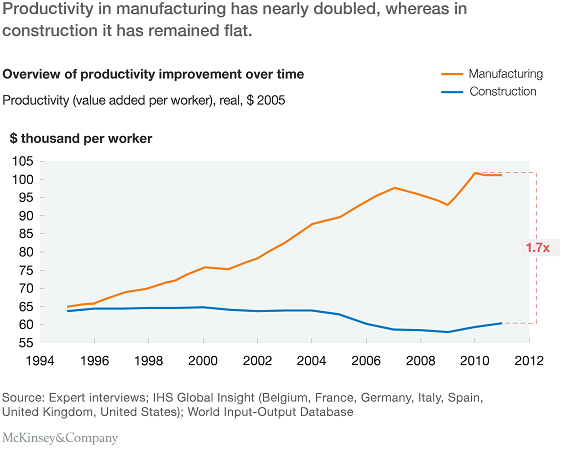AI Disruption Will Significantly Permeate the AEC Industries
Historically, the construction and building industries tend to fall on the lower scale of tech-savvy, or digital-bandwidth, owing to a lack of skilled practitioners, and a paucity of training and investment in their constituency, but more so to a general disdain for technology that creates a techno-disconnect between the design and building, and tech and building industries. The concept of ‘AI disruption’ is indeed a foreign one.
Ineptitude in the industry is not isolated: the conundrum exists in Europe, Australia, and in China

The concept of Artificial Intelligence and AI disruption is interpolated in many different ways, depending on who you talk to. Like any abstract subject, the less one comprehends, the less one can see the possibilities. A software developer will have considerable more insight into potential AI technology than a lay person. That said, not all lay people are of equal tech-savvy.
Historically, the building industry has maintained a Flinstonian antagonism toward productivity enhancements, as people fear (rightly) for their jobs.
Owing to a general incompetence (30% success rate) and obdurate negative productivity growth (see graph, above), the construction industry will experience AI disruption that it never saw coming. Traditionally, technology advances trickle down from the design to the building industry. Such was the case with AutoCadd, and to a lesser extent BIM. BIM is not at all well mainstreamed into the building industry, as it is with design industry, despite fake-news I have refuted in this column.
Project controls: estimation and planning – the black-sheep of the building industry family, will be one of the first professions to be (gradually) outphased as a consequence of AI evolution.
As AI Disruption Permeates, BIM Inevitably Will Be Mainstreamed
BIM is fairly well mainstreamed in the design industry for projects over the $25M level, but the caveat is that designers have become over-reliant on BIM clash-detections to the point that many may not even bother to do any at all. Those operators who do not are at high risk of imminent obsolescence at the behest of Revit Auto-route.
If current performance is any indication, the design industry is also ripe for AI disruption. Or rather, there is a lot of opportunity to streamline the design process. AI integration into the design industry will translate to a fraction of present resources for a markedly more efficient output product.
Detroit never saw the Rust Belt days ahead of them: that led to their own undoing. AI will inevitably hit the building industry, which is basically living in Bedrock.
AI disruption is already evident with platforms that generate algorithmic modeling and optimization of spaces, where the operator assigns some basic parameters and criteria, and a fully coordinated dynamic BIM model is automatically generated using generative design. You can see this in action, in the AutoDesk video, below.
In the (above) video, BIM takes a volume of space, some program criteria, and hashes out algorithmically optimized complete design models, with concrete, steel, exterior, and interior fit-out and MEP all-inclusive. As the parametrics shift, so do the design programs within.
For example, AI BIM will design the same space quite differently a schoolhouse from a pharmacy, or a zoo from a library. The video should make some of the engineering community nervous. On the other hand, there is great opportunity for forward thinking individuals and groups to contribute and thrive in an AI encroached market.
Generative Design in all its permutations
(From AutoDesk website)
Generative design mimics nature’s evolutionary approach to design. Designers or engineers input design goals into generative design software, along with parameters, such as materials, manufacturing methods, and cost constraints. Then, using cloud computing, the software explores all the possible permutations of a solution, quickly generating design alternatives. It tests and learns from each iteration what works and what doesn’t.
The GAO mandate that the design industry must use BIM in order to compete for Federal work may also motivate AI growth development. More sophisticated design operators will embrace and avail themselves of 4 and 5D BIM for complex projects as a necessity in order to
- Remain competitive
- Keep current with cutting-edge technologies
- Control labor and overhead costs
- Effect complex design changes on the fly – work that otherwise would have taken months to redesign
- Comply with accelerated timelines
- Be ready to incorporate AI BIM into their future plans
At present, and despite the fake-news, BLS and Census bureau reported in 2014 that less than 10% of all construction projects are BIM drive. This market share will markedly increase as BIM platforms become more powerful, and more accessible.
AI isn’t the same as Robotics though they are related
AI must be differentiated from other forms of semi-automation, and automation already in use. The chief differences are the self-learning and humanoid interface components, and what we call ‘intuition’ and cognitive reasoning, that AI so desperately aspires to emulate.
Automated devices are pre-programmed, and will only perform a fixed group of functions when instructed, for example, a CNC router is fed a dwg. CAD file, and fabricates and machines based on that file. Plugins like Grasshopper, for Rhino, and Dynamo, for Revit, fill the interoperability voids between BIM design and CNC fabrication platforms, to make the export process more efficient.
Semi-automated devices may include the bricklaying machine that requires a mason tender to fill the hopper and combine the mortar mix material.
Or perhaps this Hadrian bricklayer that can “build” a house in two-days
4D BIM already can generate a GANTT chart with every 3D model it associates. These models are far more accessible to SHs than any GANTT chart could ever hope to be. As SHs warm up to 4 and 5D BIM, they will start demanding them in lieu of the GANTT charts that defy their reason.
5D BIM models display a cost-loaded layer over the 3D model that is predicated on the project timeline.
These models are becoming more accurate every day, which means that they can serve planners and stakeholders by generating quantity take-offs and preconstruction schedules, data that was traditionally outsourced to project controls consultants. As more of these timelines become BIM generated, fewer CPM scheduler practitioners and estimators will be needed for preconstruction planning – and only clerical level data-gatherers for updates.
In fact, even the design industry will be affected by AI that can be taught to design (from a library) things like optimize building footprints for usable space, door placement, bath layouts on its own, obviating the need for CAD-jockeys. With interoperability and single source models working together, a considerable quotient of data-gathering support personnel is already becoming superfluous.
Here are Ten AI Disruptions for AEC
Inevitably, AI will in large part
- take a hypothetical volume of space, and design and optimize it architecturally for a given program or industry (algorithmic optimization): Industries affected: interior designers, architects, specifiers, drafters
- take a theoretical program and design the sub- and super-structural components. Industries affected:structural engineers
- take a theoretical program and design the mechanical, electrical, and plumbing components (MEP): Industries affected: MEP engineers.
- Convert a 3D BIM model to a 4D BIM model that generates quantity take-offs: Industries affected: estimators.
- Convert a 3D BIM model to a 5D BIM model that generates CPM schedules: Industries affected: Planning engineers, CPM schedulers
- Convert a 3D BIM model to a 6D BIM model that manages program for its entire life-cycle: Industries affected: operating engineers, facility managers, building managers
- Conduct ‘mundane’ tasks, such as notifications, verification, printing, distribution, and especially redundant data-gathering: Industries affected: clerical level, office managers, assistant project managers
- Generate risk-assessments from 5D BIM models: Industries affected: risk-assessors, planning engineers.
- Create an increasing impact in off-site fabrication and manufacturing industry: Industries affected building specialty trades, or 65-75% of the industry.
- Create more competition or opportunity for cheaper overseas BIM jockeys: Industries affected: BIM operators
As regards BIM operators, they will be in high demand – the only workforce subset from above that will not be decimated (decimated = reduced to 1/10th)
AI disruption is already a factor of improving bottom lines in many industries. Cost efficiency and quality control will drive the change in the building industries. The change will happen gradually, however, it is inevitable in a capitalist market. The popularity of P3s with shared risk profiles will lower the stakes of project controls, the rate of claims, and enhance Lean building practices that are also taking hold. It’s up to industry leaders to break the Flintstone-think chain with clear thinking, not bogus claims of BIM adoption.
Further Reading
Using artificial intelligence techniques for automated planning and scheduling. Raymond E. Levitt, John C. Kunz, Nabil A. Kartam. Pages 27-52 (1987
Automated planning & scheduling for space mission operations, Chien, Steve, Pasadena, CA : Jet Propulsion Laboratory, National Aeronautics and Space Administration, 2005










